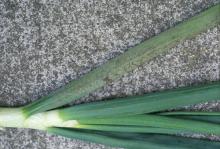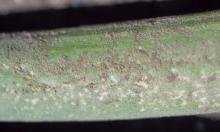See:
Onion (Allium cepa) - Stemphylium Leaf Blight and Stalk Rot
Cause Peronospora destructor, a fungus-like microorganism that overwinters on infected plants or debris. There are no resistant varieties. Many Allium spp. are affected including Egyptian onion, multiplier onion, Welsh or Spanish onion, chives, garlic, leek, and shallot as well as wild Allium spp. This disease is favored by cool (less than 72°F) and humid weather. Spores (conidia) can be wind-blown long distances and are produced at 43° to 80°F (optimum is 52° to 55°F); no spores are produced when conditions are dry with temperature above 55°F. A pathogen cycle from infection to sporulation can be completed in about 2 weeks. When weather turns hot and dry, the sporulation desiccates and plants can partially recover with the production of new, noninfected leaves but disease will return if weather turns cool and moist again. Necks on bulbs of diseased plants can remain succulent and being infected by secondary pathogens after harvest.
Symptoms Slightly pale spots develop first on leaves or seed stalks, later taking on a light brown or purplish shade. As spots enlarge, often girdling the leaves, a grayish violet furry mold develops on the spot's surface. Plants may be dwarfed, distorted, and pale green if they are systemically infected. Plants often are not killed, but bulb quality is poor and often spongy. Lesion-weakened seed stems may break, causing seed to shrivel.
Cultural control
- Plant only pathogen-free transplants, sets, and seed.
- Practice a 3-year or longer crop rotation if possible.
- Avoid poorly drained soils.
- To minimize high humidity, plant in the direction of prevailing winds, avoid using wind breaks, and manage plant density and spacing, also limit intercropping or anything else that would impede air flow.
- Don't use overhead irrigation, use drip or sub-surface irrigation.
- Destroy onion plant refuse and cull piles.
- Avoid over-application of nitrogen as an overproduction of succulent leaves promotes disease.
- Eradicate volunteer or wild Allium spp.
Chemical control During favorable weather, epidemics can build up quickly, affecting all of the foliage in several weeks. In western Oregon, when disease is present in the area and weather is favorable, well-times fungicide applications are needed prior to infection. The forecast program, DOWNCAST, can be used to optimize field scouting for spray timing but requires weather monitoring in the field.
- Plant seed treated with a metalaxyl formulation such as STartUP METXL or Allegiance FL at 0.75 fl oz/100 lb seed. 24-hr reentry.
- Actigard 50WG (Group P1) at 0.75 to 1 oz/A on a 7- to 10-day schedule for disease suppression. Begin preventative applications after thinning or after the 3- to 4-leaf stage. Preharvest interval is 7 days. 12-hr reentry.
- Copper formulations (Group M1) offer limited control.
- Badge SC at 0.75 to 2.75 pints/A on 7- to 10-day intervals. Preharvest interval is 0 days. 24-hr reentry for greenhouse use; 48-hr reentry for all other applications.
- Bonide Liquid Copper is available for home gardens. H
- Champ Formula 2 at 1.3 pints/A on 7-day intervals. Preharvest interval is 0 days. 48-hr reentry.
- Cueva at 0.5 to 2 gal/100 gal water on 7- to 10-day intervals. May be applied on the day of harvest. 4-hr reentry. O
- Cuprofix Ultra 40 Disperss at 1.25 to 3 lb/A on 7- to 10-day intervals. 48-hr reentry.
- Kocide 2000 at 1.5 lb/A or Kocide 3000 at 0.75 to 1.5 lb/A on 7- to 10-day intervals. 48-hr reentry. O
- Liqui-Cop at 2 teaspoons/gal water. H
- Nu-Cop 50 DF at 2 lb/A on 7- to 10-day intervals. 48-hr reentry. O
- Previsto at 0.75 to 2 quarts/A on 7- to 10-day intervals. 48-hr reentry. O
- CAA-fungicide formulations (Group 40) have good efficacy but must be used in combination with another fungicide that has a different mode of action. Do not apply more than once before alternating to a different mode of action.
- Forum at 6 fl oz/A on 5- to 7-day intervals. Good control when accompanied by an adjuvant was reported by UC Coop. Extension. Bulbs or leaves may be harvested on the day of the last application after sprays have dried. 12-hr reentry.
- Revus at 8 fl oz/A on 7- to 10-day intervals. Preharvest interval is 7 days. 4-hr reentry.
- Echo 720 (Group M5) on 7- to 10-day intervals at 1 to 3 pints/A for dry bulb onions and 1.5 to 3 pints/A for green bunching onions. Has limited efficacy. Do not apply within 7 days of harvest for bulb onions and within 14 days of harvest to green bunching onions. 12-hr reentry.
- Mancozeb formulations (Group M3) are labeled but offer limited efficacy.
- Dithane F45 Rainshield at 2.4 quarts/A on 7-day intervals. Do not apply within 7 days of harvest. Can be applied at 1.5 quarts/A on 7- to 10-day intervals for seed crops in Washington (SLN WA-220008). 24-hr reentry.
- Roper DF Rainshield at 3 lb/A on 7-day intervals can be used on dry bulb onions on 7- to 10-day intervals and at 2 lb/A on 7- to 10-day intervals for Allium seed crops in Washington (SLN WA-1300003). 24-hr reentry.
- Mefenoxam (Group 4) formulations are available and have good efficacy in the absence of resistant pathogen strains. Downy mildew strains can rapidly develop resistance to this fungicide group if fungicide resistance management is not practiced; do not make more than one (1) application of a Group 4 fungicide before alternating to a labeled fungicide with a different mode of action.
- Ridomil Gold Bravo SC (Group 4 + M5) at 2.5 pints/A before infection and continue on 7- to 14-day intervals. Do not apply to dry bulb onions within 7 days of harvest or to green onions within 14 days of harvest. 48-hr reentry.
- Ridomil Gold Copper (Group 4 + M1) at 2 lb/A on 14-day intervals. Preharvest 10 days dry bulb and 7 days green onions. 48-hr reentry.
- Ridomil Gold MZ (Group 4 + M3) at 2 to 2.5 lb/A. Do not apply within 7 days of harvest. For dry bulb onions only. 48-hr reentry.
- Milstop SP (85% potassium bicarbonate) at 1 Tbsp/gal water on 7- to 14-day intervals. May be applied on the day of harvest. 1-hr reentry. O
- Omega 500F (Group 29) at 1 pint/A on 7- to 10-day intervals. Do not use an adjuvant. Preharvest interval is 7 days. 12-hr reentry.
- Phosphonates (Group P7) can be very effective.
- Aliette WDG at 2 to 3 lb/A for dry bulb onions. Do not apply within 7 days of harvest. Do not combine within a copper spray program. 12-hr reentry.
- Presidio (Group 43) at 3 to 4 fl oz/A on 10-day intervals as a tank-mix. Preharvest interval is 2 days. Group 43. 12-hr reentry.
- Regalia (Group P5) at 1 to 4 quarts/A plus another fungicide on 7- to 10-day intervals. Preharvest interval is 0 days. 4-hr reentry. O
- Revus (Group 40) at 8 fl oz/A on 7- to 10-day intervals. Do not apply more than two (2) sequential applications. Do not apply within 7 days of harvest. 4-hr reentry.
- Strobilurin (Group 11) formulations are labeled for use but have low efficacy. Do not apply more than one (1) foliar application of a Group 11 fungicide before alternating to a labeled fungicide with a different mode of action.
- Quadris Flowable at 9 to 15.5 fl oz/A. When used alone in studies conducted by UC Coop Extension, gave fair control. Preharvest interval is 0 days. 4-hr reentry.
- Reason 500 SC at 5.5 fl oz/A. Do not apply within 7 days of harvest. 12-hr reentry.
- Vacres at 2.5 to 5 lb/A on 7- to 14-day intervals. Preharvest interval is zero (0) days. 4-hr reentry.
Note: Premixes of fungicides are available and offer ease for fungicide resistance management. Do not make more than one (1) application of a Group 11 fungicide before alternating to a labeled fungicide with a different mode of action; for other fungicide groups apply no more than two (2) sequential applications alternating with another fungicide with a different mode of action.
- Dexter Xcel (Group M3 + 11 +3) at 56 to 72 fl oz/A on 7- to 10-day intervals for dry bulb onion. Do not apply to exposed bulbs. Preharvest interval is 7 days. 24-hr reentry.
- ManKocide (Group M1 + M3) at 2.5 lb/A on 7-day intervals. Do not apply within 7 days of harvest. 48-hr reentry.
- Miravis Prime (Group 7 + 12) at 11.4 fl oz/A on 7-day intervals. Preharvest interval is 7 days. 12-hr reentry.
- Orondis Opti (Group M5 + 49) at 1.75 to 2.5 pints/A on 7- to 10-day intervals. Preharvest interval is 14 days for green onions, 7 days for dry onions. 12-hr reentry.
- Orondis Ultra (Group 49 + 40) at 5.5 to 8 fl oz/A on 7- to 10-day intervals. Preharvest interval is 7 days. 4-hr reentry.
- Quadris Top (Group 11 + 3) at 12 to 14 fl oz/A. Preharvest interval is 7 days. 12-hr reentry.
- Quilt Xcel (Groups 3 + 11) at 17.5 to 21 fl oz/A. May be applied the day of harvest for green onion types; 14-day pre-harvest interval for dry bulb onions. 12-hr reentry.
- Tanos (Groups 11 + 27) at 8 oz/A has good efficacy. Must be tank-mixed with an appropriate fungicide with a different mode of action (non-Group 11 or 27). Preharvest interval is 3 days. 12-hr reentry.
- Zampro (Group 40 + 45) at 14 fl oz/A offers good efficacy. Preharvest interval is 0 days. 12-hr reentry.
Biological control Efficacy in Oregon unknown.
- Actinovate AG at 3 to 12 oz/A as a foliar spray on 7- to 14-day intervals. 4-hr reentry. O
- Actinovate Lawn & Garden at 1/2 to 1 teaspoon/gal water. H O
- Double Nickel LC at 1 to 6 quarts/A on 3- to 10-day intervals. Can be applied the day of harvest. 4-hr reentry. O
- Sonata at 2 to 4 quarts/A on 7- to 14-day intervals. Can be applied up to and on the day of harvest. 4-hr reentry. O
- Stargus at 0.5 to 4 quarts/A plus a nonionic surfactant on 7- to 10-day intervals. Preharvest interval is 0 days. 4-hr reentry. O
References Turini, T.A. 2004. Comparison of fungicides for control of onion downy mildew, 2004. Plant Disease Management Report No. 60:V124.
Turini, T.A., Brotslaw, D.J., and Larios, J.A. Comparison of fungicides for control of onion downy mildew, 2003. Plant Disease Management Report No. 59:V097.



